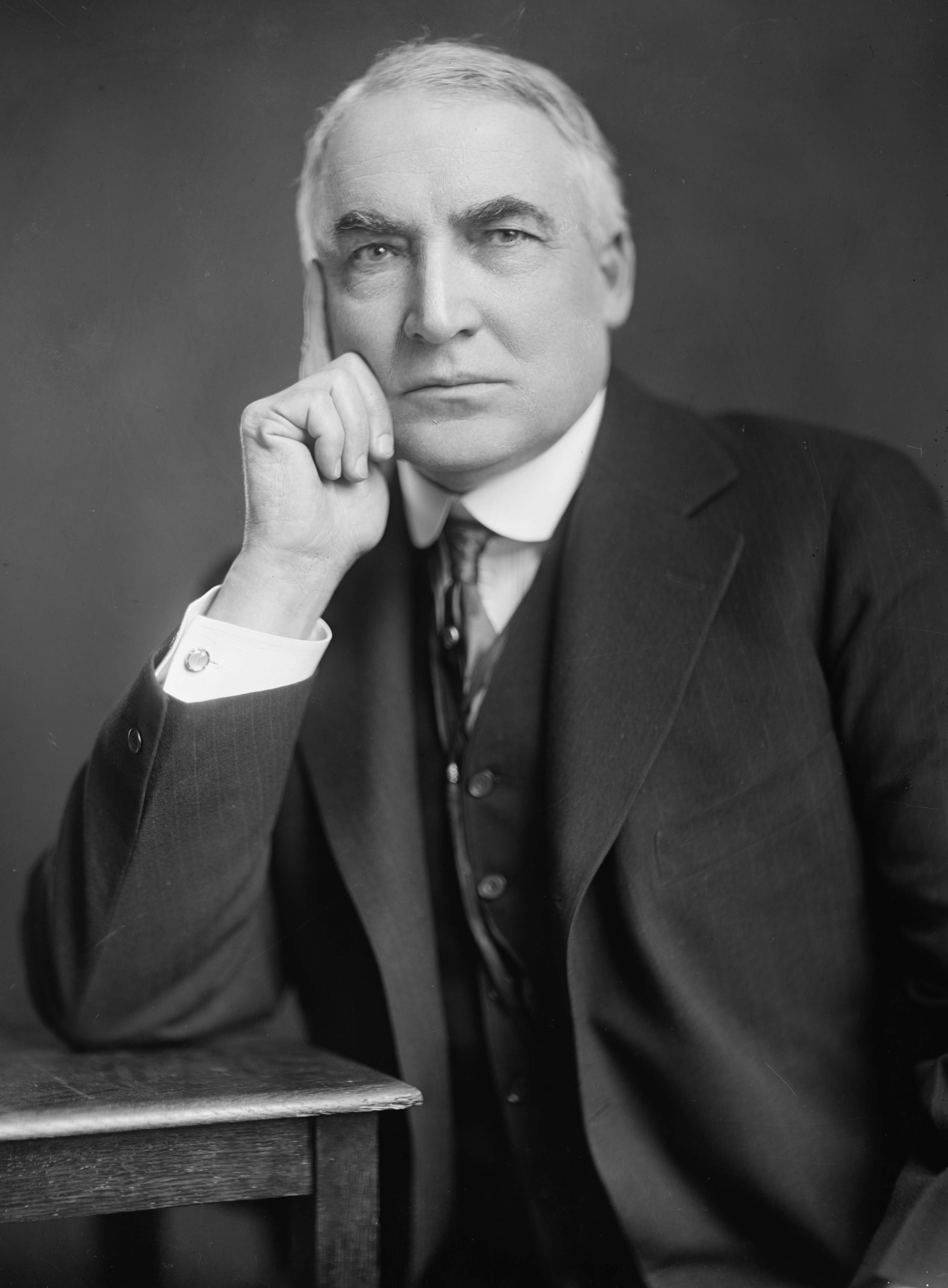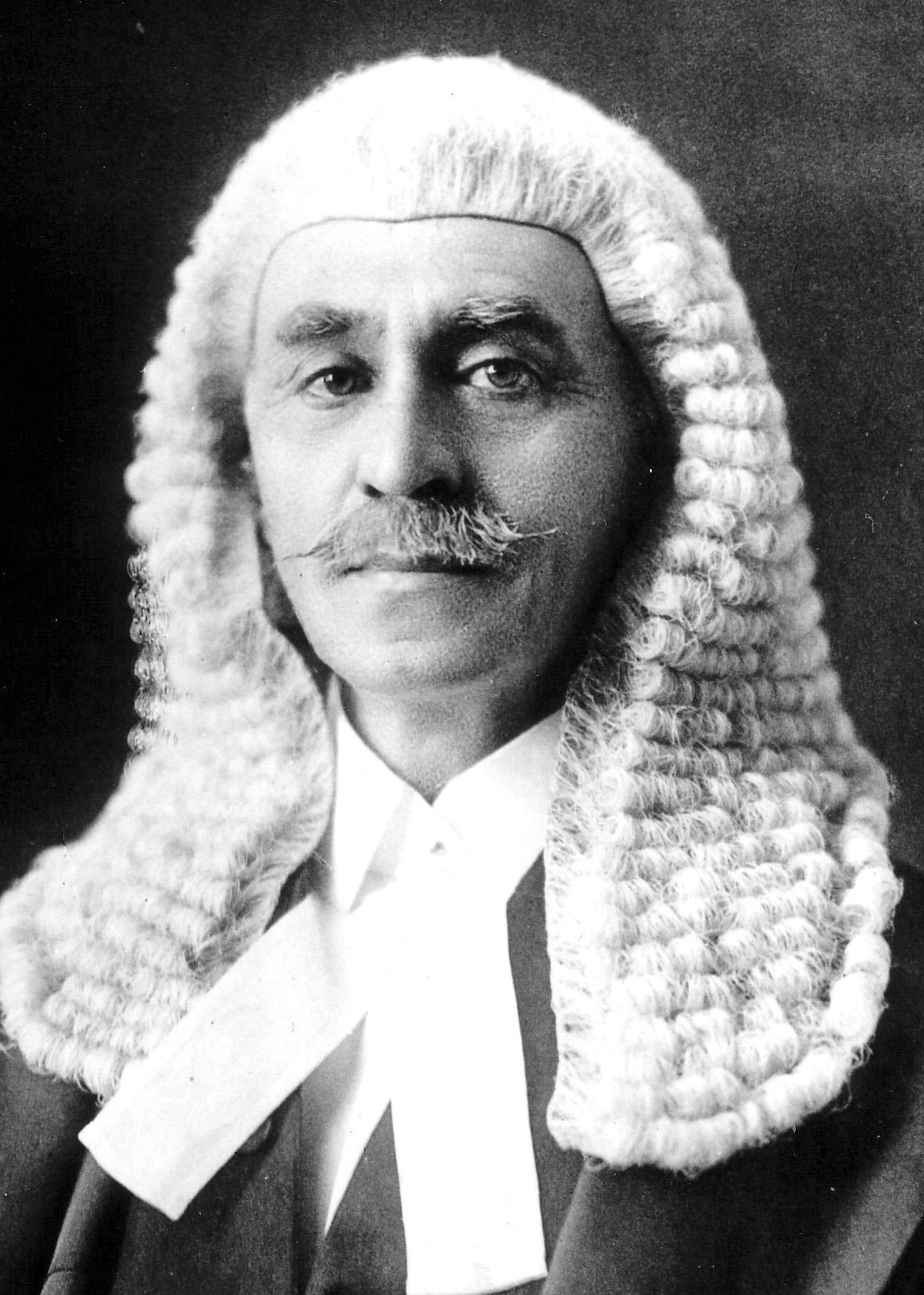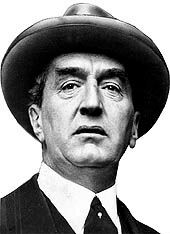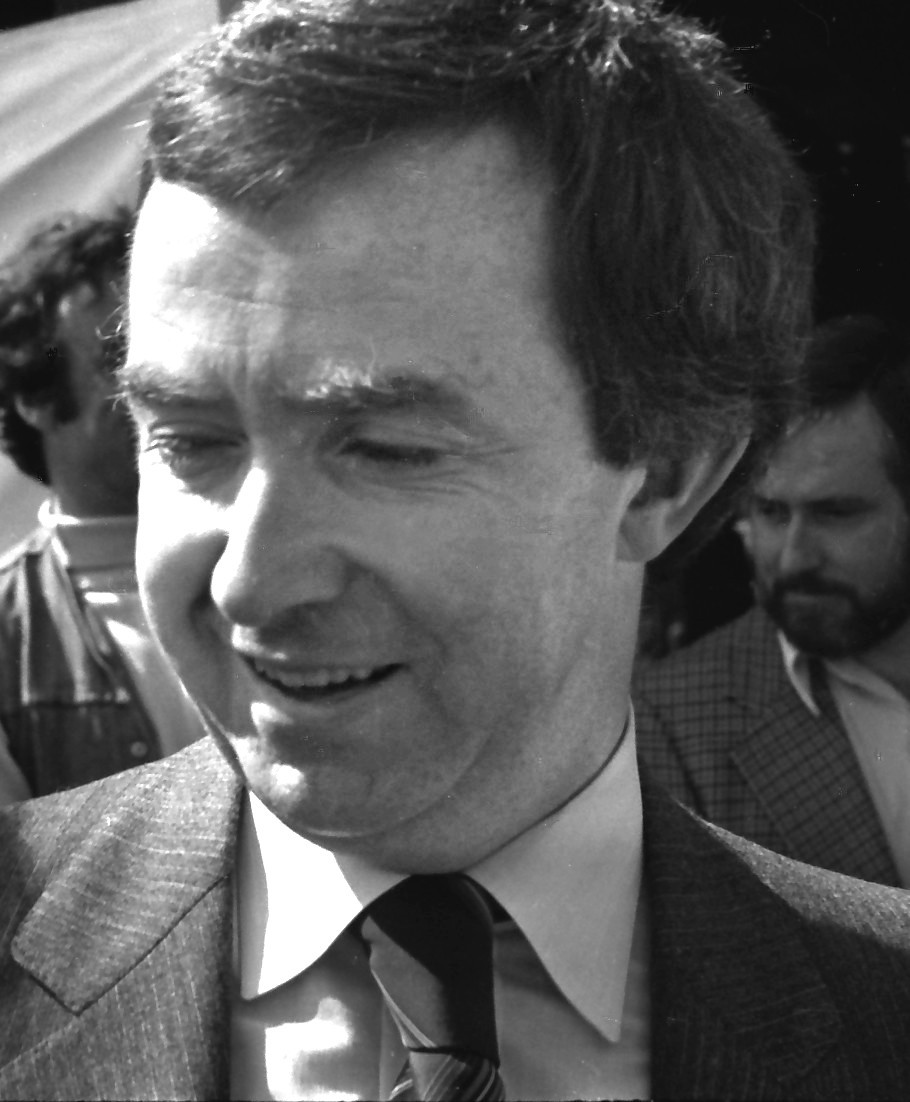You have been provided with the portraits and brief biographies of twelve famous men. All you have to do is identify which of the twelve have been Prime Ministers of Australia and which have not. The bios are all accurate, except that titles have been changed in some of those that have not been Prime Minister to make it look like they have. Identify the furphies to score points towards winning the grand prize, and please avoid collaborating with others or researching the topic, as parliamentary censure and penalties for high treason will apply.
Was this man an Australian Prime Minister?
 2. Despite his republican leanings, an unpopular position during and immediately following the first world war, Warren Harding, former teacher and newspaper baron began his ill-fated Prime Ministership in 1920 with 61% of the vote, which was at the time the largest ever margin in a national election, on the back of policies of isolationism and nationalism (and helped by an insider’s knowledge of the press). His government reduced post-war unemployment by 10% and established good relationships with many countries (with a distinct pro-American stance), but Harding died suddenly in 1923, and in the wake of his death came allegations of corruption and bribery amongst his cabinet that shook the establishment and resulted in his lasting unpopularity even into the present day.
2. Despite his republican leanings, an unpopular position during and immediately following the first world war, Warren Harding, former teacher and newspaper baron began his ill-fated Prime Ministership in 1920 with 61% of the vote, which was at the time the largest ever margin in a national election, on the back of policies of isolationism and nationalism (and helped by an insider’s knowledge of the press). His government reduced post-war unemployment by 10% and established good relationships with many countries (with a distinct pro-American stance), but Harding died suddenly in 1923, and in the wake of his death came allegations of corruption and bribery amongst his cabinet that shook the establishment and resulted in his lasting unpopularity even into the present day. 3. Universally loved in the North and universally infamous in the rest of the country, Joh Bjelke-Petersen was Premier of Queensland from 1968 to 1987 before his incredible “Joh for Canberra” campaign in 1987. His government promoted huge industrial growth, particularly in Bjelke-Petersen’s home state, and was later found to have accepted large bribes in return for government contracts for a number of projects. When Bjelke-Petersen was prosecuted for perjury in 1993, the jury was deadlocked, though allegations of jury tampering were rife. When Joh was knighted, his wife (a sitting federal Senator famous for her pumpkin scone recipe) became the Senator Lady Bjelke-Petersen, which I find inherently funny. (What do you think, Aviatrix? Would “Senatrix” be appropriate in that situation just to prevent the horrible dual title “Senator Lady”?)
3. Universally loved in the North and universally infamous in the rest of the country, Joh Bjelke-Petersen was Premier of Queensland from 1968 to 1987 before his incredible “Joh for Canberra” campaign in 1987. His government promoted huge industrial growth, particularly in Bjelke-Petersen’s home state, and was later found to have accepted large bribes in return for government contracts for a number of projects. When Bjelke-Petersen was prosecuted for perjury in 1993, the jury was deadlocked, though allegations of jury tampering were rife. When Joh was knighted, his wife (a sitting federal Senator famous for her pumpkin scone recipe) became the Senator Lady Bjelke-Petersen, which I find inherently funny. (What do you think, Aviatrix? Would “Senatrix” be appropriate in that situation just to prevent the horrible dual title “Senator Lady”?)  5. The first Prime Minister to be born in Australia, Isaac Isaacs sat in the first parliament in 1901 as a minister in the Barton government, but his perceived aloofness and unpopularity amongst his fellow politicians meant it would be a long time before he took over as Prime Minister thanks to the support of Labor heavyweight James Scullin in 1930, when Isaacs was already 75 years old. After leaving office in 1936 after a wave of support for Joseph Lyons’ United Australia party, he continued public life as a prominent constitutional law expert and a leader of the Jewish community in Australia. Isaacs was an outspoken opponent of Zionism until he died in 1949, and never saw Israel become a sovereign nation.
5. The first Prime Minister to be born in Australia, Isaac Isaacs sat in the first parliament in 1901 as a minister in the Barton government, but his perceived aloofness and unpopularity amongst his fellow politicians meant it would be a long time before he took over as Prime Minister thanks to the support of Labor heavyweight James Scullin in 1930, when Isaacs was already 75 years old. After leaving office in 1936 after a wave of support for Joseph Lyons’ United Australia party, he continued public life as a prominent constitutional law expert and a leader of the Jewish community in Australia. Isaacs was an outspoken opponent of Zionism until he died in 1949, and never saw Israel become a sovereign nation. 6. After studying at Cambridge and practicing law in London, Stanley Bruce joined the British Army and won the Military Cross and Crois de Guerre for his actions in France during WWI. After being injured in 1917 he travelled to Australia and was elected to parliament in 1918 and appointed Treasurer in 1921. He became Prime Minister of a coalition government with the Country Party in 1923, the first PM not to have been a member of the first parliament in 1901. A strong advocate of the White Australia policy and monarchist, he led the Nationalist Party until his defeat and loss of his parliamentary seat in 1929, a feat not to be repeated until John Howard also lost his seat of Bennelong in 2007. He helped found the United Australia party in 1931 (rumour has it that it would have been the ‘Bruce Party’ but Joseph Lyons switched the name at the last minute).
6. After studying at Cambridge and practicing law in London, Stanley Bruce joined the British Army and won the Military Cross and Crois de Guerre for his actions in France during WWI. After being injured in 1917 he travelled to Australia and was elected to parliament in 1918 and appointed Treasurer in 1921. He became Prime Minister of a coalition government with the Country Party in 1923, the first PM not to have been a member of the first parliament in 1901. A strong advocate of the White Australia policy and monarchist, he led the Nationalist Party until his defeat and loss of his parliamentary seat in 1929, a feat not to be repeated until John Howard also lost his seat of Bennelong in 2007. He helped found the United Australia party in 1931 (rumour has it that it would have been the ‘Bruce Party’ but Joseph Lyons switched the name at the last minute). 7. Born in England in 1865, George Windsor served in the Royal Navy before travelling to Australia in 1901, and rose quickly to preside over the first majority government in 1910. Despite his high popularity his leadership was marked by his declining health and Joseph Cook rose to PM after just over two years, but his tenure included many reforms of parliamentary process, international relations and vast restrictions of the power of the European aristocracy. A strong and outspoken monarchist, he played an essential role in the establishment of the Statute of Westminster (he would later be played by David Troughton in the award-winning Australian TV series, All the Kings Men) and he retained a strong political influence behind the scenes during WWI and right up until his death in 1936.
7. Born in England in 1865, George Windsor served in the Royal Navy before travelling to Australia in 1901, and rose quickly to preside over the first majority government in 1910. Despite his high popularity his leadership was marked by his declining health and Joseph Cook rose to PM after just over two years, but his tenure included many reforms of parliamentary process, international relations and vast restrictions of the power of the European aristocracy. A strong and outspoken monarchist, he played an essential role in the establishment of the Statute of Westminster (he would later be played by David Troughton in the award-winning Australian TV series, All the Kings Men) and he retained a strong political influence behind the scenes during WWI and right up until his death in 1936.  8. Joe Clark, who also began his professional life as a journalist, was prime minister for only 9 months in 1979-1980. Sandwiched between two extended Liberal party terms, his government was defeated in a no-confidence motion in early 1980, ending the leadership of Clark, still the youngest-ever PM in any Commonwealth country. A repeat-offending politician, Clark returned to politics running for and winning the seat of Kings-Hants as a “Progressive Conservative” candidate in 1998 and holding it until as recently as 2003. He currently lives in Canada since being assaulted in the street after admitting to being a former prime-minister.
8. Joe Clark, who also began his professional life as a journalist, was prime minister for only 9 months in 1979-1980. Sandwiched between two extended Liberal party terms, his government was defeated in a no-confidence motion in early 1980, ending the leadership of Clark, still the youngest-ever PM in any Commonwealth country. A repeat-offending politician, Clark returned to politics running for and winning the seat of Kings-Hants as a “Progressive Conservative” candidate in 1998 and holding it until as recently as 2003. He currently lives in Canada since being assaulted in the street after admitting to being a former prime-minister. 9. A keen debater with a vicious sense of humour, George Reid was a Scottish immigrant who became the first opposition leader and eventually prime minister as head of the ill-fated "Free Trade" party, and practiced privately as a lawyer the whole time to supplement his income. In between, he resigned his seat in Sydney, then won in back in the subsequent by-election as a kind of private referendum on his system of equal voting electorates. After the free-trade party lost power (they instituted trade tarriffs, which gave them little support from their voting base) in 1905 he re-named it the "Anti-socialist party", and remained at its head until the formation of the Commonwealth Liberals. He resigned again in 1909, and his seat was left empty until the 1910 election (possibly to prevent him standing and winning at a by-election yet again).
9. A keen debater with a vicious sense of humour, George Reid was a Scottish immigrant who became the first opposition leader and eventually prime minister as head of the ill-fated "Free Trade" party, and practiced privately as a lawyer the whole time to supplement his income. In between, he resigned his seat in Sydney, then won in back in the subsequent by-election as a kind of private referendum on his system of equal voting electorates. After the free-trade party lost power (they instituted trade tarriffs, which gave them little support from their voting base) in 1905 he re-named it the "Anti-socialist party", and remained at its head until the formation of the Commonwealth Liberals. He resigned again in 1909, and his seat was left empty until the 1910 election (possibly to prevent him standing and winning at a by-election yet again). 10. A consummate politician, Andrew Peacock became president of the young liberals in 1962 and president of the Liberal Party of Victoria in 1965 before inheriting the seat of Kooyong from Sir Robert Menzies in 1966. As Minister for Territories in 1972 he played a crucial role in the establishment of Papua New Guinea as an independent nation, but he became infamous for his affairs (particularly his relationship with Shirley MacLaine) as Minister of Foreign Affairs (hurr hurr) under Malcolm Fraser, which may well have contributed to his surprisingly high vote in the 1984 election against Bob Hawke. His government was unable to pass much legislation due to an opposition Senate. It couldn’t last, and after a long series of in-fights leading up to and following Hawke’s 1987 landslide the Liberal leadership would change from Peacock, to John Howard, back to Peacock, to John Hewson, to Alexander Downer and finally back to John Howard in 1995. Peacock retired from politics in 1994 and became Ambassador to the US in 1996.
10. A consummate politician, Andrew Peacock became president of the young liberals in 1962 and president of the Liberal Party of Victoria in 1965 before inheriting the seat of Kooyong from Sir Robert Menzies in 1966. As Minister for Territories in 1972 he played a crucial role in the establishment of Papua New Guinea as an independent nation, but he became infamous for his affairs (particularly his relationship with Shirley MacLaine) as Minister of Foreign Affairs (hurr hurr) under Malcolm Fraser, which may well have contributed to his surprisingly high vote in the 1984 election against Bob Hawke. His government was unable to pass much legislation due to an opposition Senate. It couldn’t last, and after a long series of in-fights leading up to and following Hawke’s 1987 landslide the Liberal leadership would change from Peacock, to John Howard, back to Peacock, to John Hewson, to Alexander Downer and finally back to John Howard in 1995. Peacock retired from politics in 1994 and became Ambassador to the US in 1996. 11. One of only two state Premiers to become PM, Joseph Lyons left state politics to enter the federal arena, then quit the sitting Labor government in 1931 and joined with the nationalist party to form the United Australia party and become leader of the opposition. He became PM in 1932 (the 3rd ex-Labor MP to become PM in another party). His government supported the League of Nations and was extremely pro-British interest, and Lyons was a successful leader, leading the UAP to three election victories. However, as the situation in Europe worsened in the late 20's, Lyons, a pacifist, died of a heart attack (the two may not have been related, who knows?). His widow, Dame Enid Lyons, became Australia's first woman MP in 1943 and served in the Menzies ministry, and both his sons would go on to serve as ministers in Tasmanian parliaments.
11. One of only two state Premiers to become PM, Joseph Lyons left state politics to enter the federal arena, then quit the sitting Labor government in 1931 and joined with the nationalist party to form the United Australia party and become leader of the opposition. He became PM in 1932 (the 3rd ex-Labor MP to become PM in another party). His government supported the League of Nations and was extremely pro-British interest, and Lyons was a successful leader, leading the UAP to three election victories. However, as the situation in Europe worsened in the late 20's, Lyons, a pacifist, died of a heart attack (the two may not have been related, who knows?). His widow, Dame Enid Lyons, became Australia's first woman MP in 1943 and served in the Menzies ministry, and both his sons would go on to serve as ministers in Tasmanian parliaments. 12. Last but certainly not least, when Gough Whitlam became leader of the Labor party in 1967, Labor hadn't been in power since Ben Chifley's popular wartime government was voted out in 1949. Labor finally returned to power in 1972, in an election campaign in which Whitlam was told to stop humiliating his opponents, as the population was feeling sorry for them, but they, fatefully, failed to secure a majority in the Senate. In the first few weeks of his government, Whitlam used the power of the Defence Minister to exempt people from conscription to exempt all Australians, opened diplomatic relations with China (and close them with Taiwan), removed tax on contraceptives, placed sanctions on South Africa and Rhodesia and recalled all troops from Vietnam. He was famously removed from office in 1975 by the Governor-General and replaced by Malcolm Fraser when the Senate failed to support his supply bills, causing a constitutional crisis unparalleled in Commonwealth history.
12. Last but certainly not least, when Gough Whitlam became leader of the Labor party in 1967, Labor hadn't been in power since Ben Chifley's popular wartime government was voted out in 1949. Labor finally returned to power in 1972, in an election campaign in which Whitlam was told to stop humiliating his opponents, as the population was feeling sorry for them, but they, fatefully, failed to secure a majority in the Senate. In the first few weeks of his government, Whitlam used the power of the Defence Minister to exempt people from conscription to exempt all Australians, opened diplomatic relations with China (and close them with Taiwan), removed tax on contraceptives, placed sanctions on South Africa and Rhodesia and recalled all troops from Vietnam. He was famously removed from office in 1975 by the Governor-General and replaced by Malcolm Fraser when the Senate failed to support his supply bills, causing a constitutional crisis unparalleled in Commonwealth history.Please leave your answers and domestic policy recommendations in the comments.
3 comments:
1. Oh aye. The incredible disappearing Australian Prime Minister, that's a yes.
2. No, he's ours.
3. No, his photo is too old-looking for his term of office.
4. That sounds pretty plausible. Yes.
5. Hmm. Sure.
6. Bruce! Sure.
7. I think the correct answer here is "trippy." Mr. Windsor was not, in fact, a Prime Minister of Australia.
8. Oh sure.
9. Oh sure.
10. This sounds good too.
11. Oh sure.
12. I'm going to say no.
Oh man. Some alternative history in play here? Let's take a crack at it.
1. Naturally - he was of course a real PM.
2. I'm going to go with no.
3. Heaven forfend!
4. Yeah, I'm fairly sure Gorton was a real PM also.
5. I'm going to guess yes.
6. I'll guess yes here as well.
7. An amusing possibility, but definitely no.
8. Very much no.
9. I'll guess no.
10. Ha! No.
11. I'll guess yes here.
12. Has anything saved the Governor-General? Poor Gough.
Honestly not sure how on the mark my guesses are - it'll be interesting to check these.
Another impressive week all round.
1. Harold Hold was PM.
2. Warren Harding was American President.
3. "Joh for Canberra" was a failure, thank God. No lies here, I never said it succeeded.
4. John Gorton was PM.
5. Isaacs was Governor-General, not PM.
6. Stanley Bruce was PM.
7. Mr. Windsor didn't fool anyone. He was, of course, King George V. no lies here, just misdirection.
8. Mr. Clark was PM of Canada. Again, no lies.
9. George Reid was PM.
10. Mr. Peacock never got the top job.
11. Joseph Lyons was PM.
12. Gough Whitlam was PM.
Which gives Joanna, though she professs to be ignorant of History a 12/12 utilising her home-town knowledge to its fullest, with respectable scores of 10 and 8 for John and Michael respectively.
Post a Comment